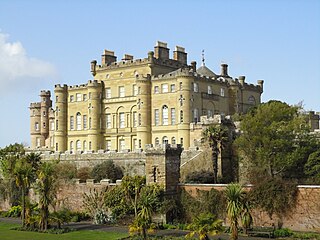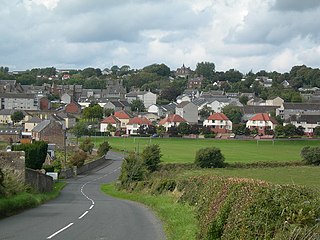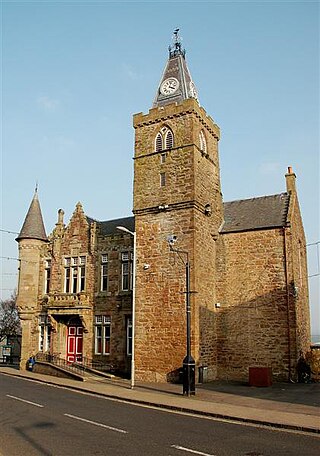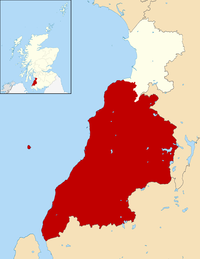
Marquess of Ailsa, of the Isle of Ailsa in the County of Ayr, is a title in the Peerage of the United Kingdom. It was created on 10 September 1831 for Archibald Kennedy, 12th Earl of Cassilis. The title Earl of Cassilis had been created in 1509 for the 3rd Lord Kennedy. This title had been created in the Peerage of Scotland in 1457. The 1st Marquess had been created Baron Ailsa in the Peerage of the United Kingdom on 12 November 1806.

Clan Fergusson is a Scottish clan. Known as the Sons of Fergus they have spread across Scotland from as far as Ross-shire in the north to Dumfriesshire in the south.

Culzean Castle is a castle overlooking the Firth of Clyde, near Maybole, Carrick, in South Ayrshire, on the west coast of Scotland. It is the former home of the Marquess of Ailsa, the chief of Clan Kennedy, but is now owned by the National Trust for Scotland. The clifftop castle lies within the Culzean Castle Country Park and is opened to the public. From 1972 until 2015, an illustration of the castle was featured on the reverse side of five pound notes issued by the Royal Bank of Scotland.

Clan Kennedy is a Scottish clan of the Scottish Lowlands.

Maybole is a town and former burgh of barony and police burgh in South Ayrshire, Scotland. It had an estimated population of 4,580 in 2020. It is situated 9 miles (14 km) south of Ayr and 50 miles (80 km) southwest of Glasgow by the Glasgow and South Western Railway. The town is bypassed by the A77.

Dunure Castle is located on the west coast of Scotland, in South Ayrshire, about five miles south of Ayr and close to the village of Dunure. Today the castle stands in ruins on a rocky promontory on the Carrick coast, overlooking the small harbour of Dunure.

The Abbey of Saint Mary of Crossraguel is a ruin of a former abbey near the town of Maybole, South Ayrshire, Scotland. Although it is a ruin, visitors can still see the original monks’ church, their cloister and their dovecot.
John Faa or Faw, the King of the Gypsies, was a historical character from Scotland, a contemporary of King James V. Although historical sources place him in Dunbar, in the east of Scotland, much folklore associates him with the Galloway/Ayrshire border.

Carrick Academy is a state-run secondary school, administered by South Ayrshire Council and situated in the Maybole Community Campus in the town of Maybole, South Ayrshire. It serves about 550 pupils, from the town of Maybole and the villages of Dalrymple, Crosshill, Kirkmichael, Straiton, Minishant, Dunure, Dailly, Kirkoswald, Maidens, and surrounding farms. Carrick Academy was last inspected by Education Scotland in March 2015.

Greenan Castle is a 16th-century ruined tower house, around 2+1⁄2 miles southwest of Ayr in South Ayrshire, Scotland. Situated at the top of a sea cliff, it was originally a promontory fort converted into a motte-and-bailey in the 12th century. In the 15th century a tower house was built by the Lords of the Isles, which later passed into the hands of the Kennedy family.
John Kennedy, 5th Earl of Cassilis was a Scottish peer, the son of Gilbert Kennedy, 4th Earl of Cassilis and Margaret Lyon.

Dunduff Castle is a restored stair-tower in South Ayrshire, Scotland, built on the hillside of Brown Carrick Hills above the Drumbane Burn, and overlooking the sea above the village of Dunure.

Minishant is a village bordering the A77 in the old county of Carrick, South Ayrshire, Scotland. It is located in Maybole Parish, 3+1⁄2 miles from Maybole and standing close to the River Doon. The village was originally named Culroy after the Culroy Burn that runs through it.
Gilbert Kennedy of Bargany and Ardstinchar was a Scottish landowner and murder victim. Kennedy had inherited a long-standing family feud with John Kennedy, 5th Earl of Cassilis, on the death of his father, Thomas Kennedy of Bargany. On 11 December 1601 he met the Earl and his followers at Pennyglen near Maybole and was murdered with a lance thrust in his back.

Jean Stewart, Lady Bargany was a Scottish lady in waiting to Anne of Denmark. She was a younger daughter of Andrew, Master of Ochiltree and Margaret Stewart, Mistress of Ochiltree. Jean was a maiden in the household of Anne of Denmark and her mother was the senior lady in waiting. Her marriage is of special interest to historians.
Thomas Kennedy of Bargany was a Scottish courtier and landowner.

Margaret Kennedy, Countess of Cassilis was a Scottish aristocrat.

Maybole Town Hall is a municipal structure in the High Street in Maybole, South Ayrshire, Scotland. The structure, which is used as a community events venue, is a Category B listed building.
Thomas Kennedy of Culzean was a Scottish landowner involved in a feud and a murder victim.


















